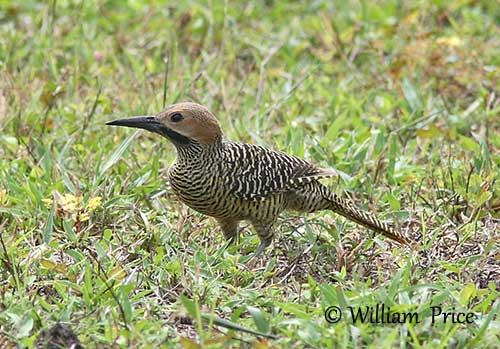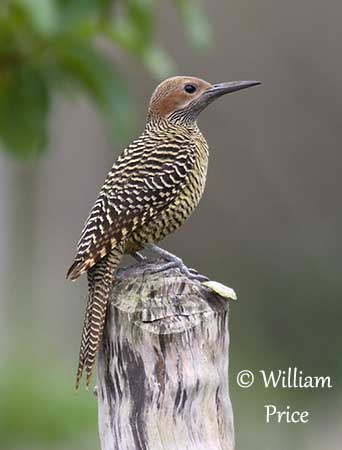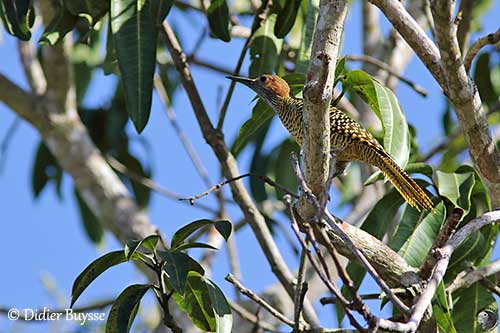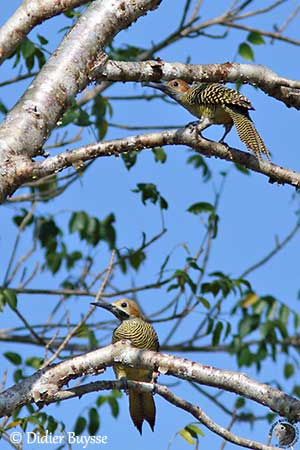
Fr: Pic de Fernandina
Ang: Fernandina’s Flicker
All: Kubaspecht
Esp: Carpintero Churroso
Ita: Picchio di Fernandina
Nd: Cubaanse Grondspecht
Sd: zapataspett
Photographers:
Didier Buysse
Vision d’Oiseaux
William Price
PBase-tereksandpiper & Flickr William Price
Text by Nicole Bouglouan
Sources:
HANDBOOK OF THE BIRDS OF THE WORLD Vol. 7 by Josep del Hoyo-Andrew Elliott-Jordi Sargatal – Lynx Edicions – ISBN: 8487334377
BIRDS OF THE WEST INDIES – by Herbert Raffaele, Kristin Williams et Tracy Pedersen – Helm – ISBN: 9780713649055
Arthur Grosset's Birds (Arthur Grosset)
Wikipedia, the free encyclopaedia
Neotropical Birds – Cornell Lab of Ornithology
Fernandina’s Flicker
Colaptes fernandinae
Piciformes Order – Picidae Family
INTRODUCTION:
The Fernandina’s Flicker is included in the subfamily Colaptini in the large family Picidae. This species is very distinctive with its long, pointed, curved bill, on which the nostrils are exposed and not covered by feathers.
The Fernandina’s Flicker is endemic to Cuba where it is restricted to some areas on the island. This beautiful bird is often seen foraging on the ground while searching for ants.
This species is today listed as Vulnerable with small, declining and fragmented population, largely threatened by habitat loss.

The Fernandina’s Flicker female resembles male, but she lacks the black malar stripe. She has dark malar area heavily streaked white.
The juvenile is duller and browner than adults. It has less barred upperparts and broader bars below.
RANGE:
The Fernandina’s Flicker is endemic to Cuba where it is now patchily distributed.
HABITAT:
The Fernandina’s Flicker frequents savanna edges and open forests with palms, less often denser woodlands. It can be found in dry or wet areas, and it is closely associated with palm for nesting, especially the species Sabal parviflora of family Arecaceae.
CALLS AND SONGS: SOUNDS BY XENO-CANTO
The Fernandina’s Flicker gives loud “pic-pic-pic-pic-pic-pic” slower and lower than Northern Flicker. During the breeding season, it utters a loud, nasal, short “ch-ch-ch” even from the nesting cavity.
BEHAVIOUR IN THE WILD:
The Fernandina’s Flicker feeds on various invertebrates such as insects, worms and grubs, and especially ants that are its preferred food. It also consumes seeds.
It often forages alone on the ground, usually in areas with scattered trees and thick leaf litter. It probes into the soil and under fallen dead leaves. It can be found on lawns and dusty tracks.
However, during the breeding season, they often forage in pairs, and both mates roost together.

The Fernandina’s Flicker performs courtship displays in December/January, and the nesting hole is excavated in February/March. It often uses nest holes begun by other woodpeckers, usually the West Indian Woodpecker, and it finishes the excavation.
During the breeding season, the male becomes aggressive. Both mates engage in strong aerial chases during this period. Some fights occur between males for nesting sites.
The Fernandina’s Flicker is resident on Cuba. Like other woodpeckers, its flight is undulating.
REPRODUCTION OF THIS SPECIES:
The breeding season takes place between March and June. The Fernandina’s Flicker excavates the nest in dead or live palm, often Sabal parviflora, or in other dead tree. The cavity is usually relatively close to the ground, between 3 and 6 metres. The cavity depth is about 60 centimetres and the entrance has a diameter of 8-9 centimetres. The same nest hole can be used in several following years.
This species often breeds in loose colonies at Bermeja, in the Zapata Swamp.
The female lays 3-5 white eggs. The incubation lasts about 18 days, shared by both adults which have well-developed brood patches. The chicks are naked at hatching. They are fed by both parents. They fledge about 3 weeks after hatching.
PROTECTION / THREATS / STATUS:
The Fernandina’s Flicker is now restricted to some areas on the island. The species suffered rapid decline due mainly to habitat loss, through logging and clearance of forest for agriculture expansion. The hurricanes also have a negative impact on populations.
The Fernandina’s Flicker is also an indirect victim of parrot’s trade. It often nests in the same palms as Cuban Amazon, and its nest is often destroyed when the young parrots are collected.
The population is estimated to number 600/800 individuals, equating to 400/530 mature individuals.
The Fernandina’s Flicker is listed as Vulnerable. It is very rare with small, declining population.

DESCRIPTION OF THE BIRD:
Biometrics:
Length: 33-35 cm
The Fernandina’s Flicker male has pale yellow to yellowish upperparts, wing-coverts and tertials, heavily barred blackish. Rump and uppertail-coverts are paler with narrower bars. On the upperwing, the flight-feathers are mostly dark brown with narrow, yellow-buff bars. The uppertail is brownish-black with narrow, buff-yellow bars on rectrices.
The underparts are pale yellowish-buff with heavy dark brown barring, slightly weaker on belly. Underwing and undertail are yellow with weak dark barring.
The male has buff-cinnamon head with fine black streaking. The lores are slightly paler, like a narrow line above and below the eye. The ear-coverts are uniformly cinnamon, slightly darker at rear. We can see a conspicuous black malar stripe, occasionally with some red tinge. Chin and throat are heavily but finely streaked black.
The long, pointed, curved bill is black, narrower on the exposed nostrils. The eyes are dark brown. Legs and feet are dark grey.
